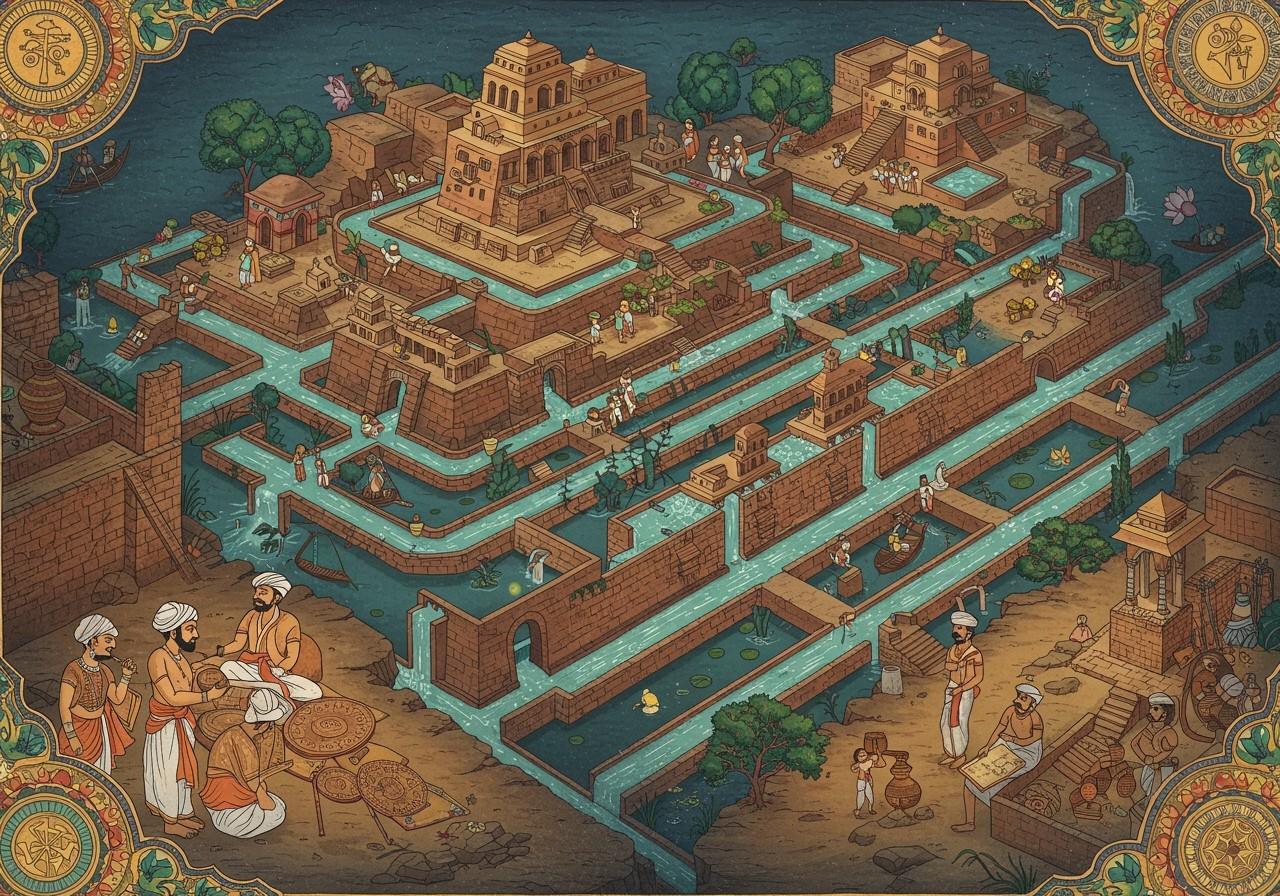
Rakhigarhi stands as a prominent landmark of the Indus Valley Civilization (2600-1900 BC). Nestled in Haryana’s Hisar district, this ancient city unveils remarkable insights into sophisticated water management practices. Exploring Rakhigarhi’s water systems allows us to grasp the ingenuity and foresight of the Indus Valley people.
Geographical Context and Importance
Located near the ancient course of the Sarasvati River, a revered river in Hindu mythology, Rakhigarhi’s layout and water management strategies were deeply influenced by the river’s presence. The region’s climate during the Indus Valley Civilization differed significantly from today, impacting how water resources were managed. Rakhigarhi held strategic importance for trade and agriculture, boasting geographical features conducive to sophisticated water systems.
Rakhigarhi’s Hydraulic Engineering
Renowned for urban planning and hydraulic engineering, the Indus Valley Civilization showcased its prowess in Rakhigarhi. Archaeologists unearthed intricate water reservoirs, demonstrating advanced construction techniques. Utilizing gravity flow and step wells built with robust materials, these water systems provided drinking water, sanitation, and facilitated irrigation. Water conservation was paramount, especially during dry spells. A comparison of Rakhigarhi’s water systems with those of Mohenjo-Daro and Harappa reveals the remarkable sophistication achieved by this civilization.
Archaeological Discoveries and Research
Excavations at Rakhigarhi have unveiled crucial components of the city’s water management infrastructure, including detailed structures of reservoirs and channels. Employing diverse methodologies, archaeologists meticulously uncovered and analyzed these systems, enriching our comprehension of the Indus Valley Civilization’s technological progress. Advanced tools and techniques played a pivotal role in preserving these invaluable structures.
Cultural and Historical Significance
Rakhigarhi’s water systems mirror the rich cultural tapestry of the Indus Valley Civilization. Water management significantly shaped social structures and daily life, featuring prominently in ceremonies and offerings. These systems bolstered economic activities like agriculture and trade, contributing to the city’s resilience. Rakhigarhi’s water management legacy continues to resonate in contemporary Indian culture and practices.
Modern Implications and Lessons
Rakhigarhi’s ancient water systems offer invaluable lessons for modern water management strategies. The underlying principles of hydraulic engineering from Rakhigarhi hold relevance for contemporary water conservation endeavors. Sustainable practices are essential in tackling current environmental challenges. Synergistically blending traditional techniques with modern technology holds the key to enhanced resource management. Preserving and studying Rakhigarhi’s water systems not only safeguards our cultural heritage but also enriches educational opportunities.
FAQs on Rakhigarhi’s Water Systems
Where is Rakhigarhi located? Rakhigarhi is situated in the Hisar district of Haryana, India.
What is the significance of Rakhigarhi? Rakhigarhi is one of the largest Indus Valley Civilization sites, offering insights into advanced water management systems.
How did the river influence Rakhigarhi? The nearby Sarasvati River played a crucial role in shaping the city’s layout and water management strategies.
What were the key features of Rakhigarhi’s water systems? Key features included reservoirs, channels, step wells, and sophisticated drainage systems, all showcasing advanced engineering.
What can we learn from Rakhigarhi’s water management? Rakhigarhi teaches us valuable lessons about sustainable water conservation and the integration of traditional knowledge with modern technology.
Poojn.in: Connecting You to India’s Rich Cultural Heritage
Poojn.in, India’s largest cultural goods and services store, offers a wide selection of products to enhance your spiritual journey. Just as water played a central role in ancient civilizations, it continues to hold significance in many cultural and religious practices today. Poojn.in provides high-quality items for various rituals and ceremonies, helping you connect with your heritage.
-
Sapta Jal (Seven Holy Waters): Experience the sanctity of seven holy waters used in traditional rituals, connecting you to the ancient reverence for water.
-
Bamboo Chalon: This traditional bamboo tray, ideal for offerings and ceremonies, reflects the resourcefulness of ancient civilizations in utilizing natural materials. Discover the beauty and utility of this handcrafted item.
-
Brass Chalon: Elevate your rituals with this elegant brass tray, perfect for offerings and ceremonies. Crafted with intricate detail, this piece adds a touch of tradition and sophistication to your spiritual practices.
Conclusion
Rakhigarhi’s water systems stand as a testament to the ingenuity of the Indus Valley Civilization. They underscore the advanced engineering and meticulous planning that underpinned sustainable water management solutions. By studying these ancient techniques, we gain valuable insights applicable to modern water conservation efforts. The wisdom of Rakhigarhi emphasizes the importance of integrating traditional knowledge with contemporary technology to address current environmental challenges. Let us embrace the lessons from the past to safeguard our heritage while ensuring a sustainable future.


